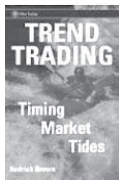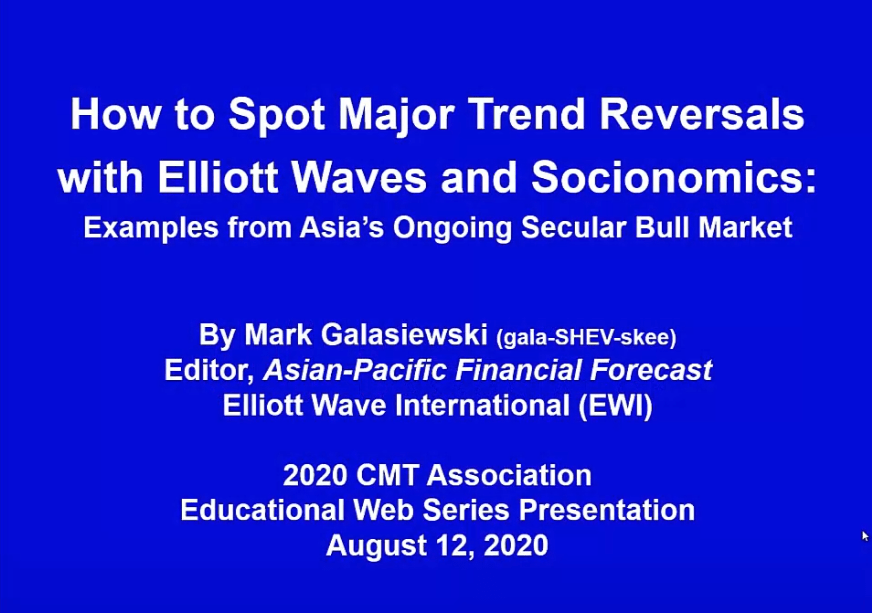From the Editor’s Desk
As always, the MTA is busy. Staff and volunteers are continuing with preparations for the upcoming Seminar. Graders are preparing to review the growing number of CMT tests. Daily operations continue to increase at an ever quickening pace. This issue of the newsletter reflects that activity and presents some interesting research on techniques of technical analysis. On the cover, Rob Brand, CMT, takes a new look at volume and analyzes institutional fund flows. He concludes that studying this data is useful, and provides a viable framework to incorporate the data into your own market studies. Looking inside the newsletter, on page 8, we publish a short study by Lawson McWhorter, CMT, looking at the volume generated by retail investors. He uses data recently made available by the New York Stock Exchange that was announced in the June Issue of Technically Speaking. His conclusion is that the usefulness of retail data in the current market environment is limited. I hope you’ll read both studies, and maybe consider doing your own work in this area. We are always happy toTo view this content you must be an active member of the TAN Association.
Not a member? Join the TAN Association and unlock access to hundreds of hours of written and video technical analysis content, including the Journal of Technical Analysis and the Video Archives. Learn more about Membership here.
What's Inside...
From the Executive’s Desk
by Tom SilveriMTA Members and Affiliates: This past month has been a very exciting time for me personally and for the MTA Headquarters Staff as we conduct reviews on what is working, what needs to be done and most...
Institutional Fund Flows: A Different Approach to Volume
by Rob Brand, CMT, FRM, PRMMany traders and analysts incorporate some form of volume analysis in their decision-making. Volume takes various forms, but one that is as yet still little used but is rapidly coming to the fore is...
In Depth Part II: Josh Rosen Interview
by Josh Rosen, CMT & Molly SchillingAn interview with Josh Rosen, CMT, a New York Stock Exchange Specialist with Kellogg Group, conducted by Molly Schilling. We continue our conversation with Josh Rosen, a Specialist on the floor of...
A Short Study of NYSE Retrac EOD data
by Lawson McWhorter, CMTThe New York Stock Exchange recently introduced a new suite of data products called InfoTools. One of these tools, Retrac, captures time, side (buy/sell), symbol, and quantity for all orders entered...
2007 Charles H. Dow Award Competition
by George A. Schade, Jr., CMTThe Charles H. Dow Award for excellence and creativity in technical analysis has been presented since 1994. The papers honored with the award have represented the richness and depth of technical...
MTA New York Region Update October 2006
by David Keller, CMTThe New York Region welcomed Connie Brown to our October meeting for a dynamic session on technical analysis and horses (no, that’s not a typo). In the first half of Connie’s presentation,...
Trend Trading: Timing Market Tides By Kedrick Brown
by Michael Carr, CMTSystems traders have long been known to employ profitable trend following strategies in the futures markets. Applying those concepts to stock trading has proven to be difficult, although the idea of...
MTA Members and Affiliates:
This past month has been a very exciting time for me personally and for the MTA Headquarters Staff as we conduct reviews on what is working, what needs to be done and most importantly what our vision is for the future. We are making progress on all fronts. Let me address just three areas this month:
I. Headquarter Staff & Library Location
Ever since the 9/11/01 disaster, the MTA has desired to return to the NYC location. We are pleased to announce that the Board of the MTA has approved that return, a site selection has been made that will service the needs of the MTA and its Members, and we expect to be housed in NYC by the start of 2007. We strongly believe the NYC presence will increase our visibility to our Members, of our library materials, calibration with affiliated sponsors, etc., and will help promote our
To view this content you must be an active member of the TAN Association.
Not a member? Join the TAN Association and unlock access to hundreds of hours of written and video technical analysis content, including the Journal of Technical Analysis and the Video Archives. Learn more about Membership here.
Contributor(s)

Tom Silveri
Bio
Many traders and analysts incorporate some form of volume analysis in their decision-making. Volume takes various forms, but one that is as yet still little used but is rapidly coming to the fore is institutional fund flows. This article looks at how one particular flows indicator, published by State Street, can be used to help anticipate market movements in global equity markets.
Flow analysis: The Underlying Idea
As the term indicates, institutional fund flows are the volumes that are traded by investment managers, such as asset managers and pension funds. In many cases, the large asset managers are the driving force behind share price movements since they hold huge positions and may take time to get into a particular sector or stock. In other words, if the institutional investors head in a particular direction, this is likely to have the effect of driving up share prices on account of the large volumes
To view this content you must be an active member of the TAN Association.
Not a member? Join the TAN Association and unlock access to hundreds of hours of written and video technical analysis content, including the Journal of Technical Analysis and the Video Archives. Learn more about Membership here.
Contributor(s)

Rob Brand, CMT, FRM, PRM
Rob Brand, who holds the Chartered Market Technician (CMT) designation, is the Head of Portfolio Management at Blue Sky Group in Amsterdam, which he joined in 2011 after spending several years at ABN Amro Asset Management. In his current position, Rob manages the tactical asset...
An interview with Josh Rosen, CMT, a New York Stock Exchange Specialist with Kellogg Group, conducted by Molly Schilling.
We continue our conversation with Josh Rosen, a Specialist on the floor of the New York Stock Exchange. We are at the famous Bobby Van Restaurant on Wall Street.
Molly Schilling: What do you think of the proposed merger between The New York Stock Exchange and Euronext?
Josh Rosen: You know I have to say this, I’m still wrapping my arms around hybrid and the new technological advances at The New York Stock Exchange. John Thain came in here, and I don’t know if he was always a fan of the listed marketplace, but I do know that he has become a huge proponent of it now. Here’s a guy coming in from Goldman Sacks, takes a look and says I’m a technology guy. And then after actually seeing the type of price discovery
To view this content you must be an active member of the TAN Association.
Not a member? Join the TAN Association and unlock access to hundreds of hours of written and video technical analysis content, including the Journal of Technical Analysis and the Video Archives. Learn more about Membership here.
Contributor(s)

Josh Rosen, CMT
Josh Rosen, CMT is a Senior Domestic Trader at Driehaus Capital Management and Driehaus

Molly Schilling
Molly Schilling is an independent trader and freelance writer. Molly has been a member of the MTA since
The New York Stock Exchange recently introduced a new suite of data products called InfoTools. One of these tools, Retrac, captures time, side (buy/sell), symbol, and quantity for all orders entered by retail investors. The data is reported in real-time as well as aggregated by symbol and made available nightly via a NYSE ftp site. End-of-day data from March 23rd 2005, the fi rst available date historically, through August 31st 2006 is the focus of this short study.
Sentiment analysis has long been a staple of the market technician’s toolbox. This type of analysis generally attempts to identify extremes in investor psychology that often presage market reversals. Traditionally, the small investor–the proverbial odd-lotter of yesteryear–has been considered the “dumb” money and the most fertile subject for contrarian analysis.
Advances in technology, market structure, and regulation have all leveled the playing field, yet the assumption of the unsophisticated retail investor and the cool,
To view this content you must be an active member of the TAN Association.
Not a member? Join the TAN Association and unlock access to hundreds of hours of written and video technical analysis content, including the Journal of Technical Analysis and the Video Archives. Learn more about Membership here.
Contributor(s)

Lawson McWhorter, CMT
W. Lawson McWhorter, CMT has been a member of the MTA since 1993. He currently works for the Structured Products Group of a global investment firm helping manage quantitative
The Charles H. Dow Award for excellence and creativity in technical analysis has been presented since 1994. The papers honored with the award have represented the richness and depth of technical analysis. Having been involved with the Dow Award since first presented, I believe it is the most important recognition in the field of technical analysis.
The competition for the 2007 Dow Award is open. The last day to submit papers for consideration will be February 28, 2007.
The guidelines have been reviewed and revised. Two major changes have been made. The standards for judging a paper have been raised to require accepted models of testing and robust research, and for the first time, a cash prize of $1,000 will accompany the award.
The winning author will also be invited to discuss the paper at a national MTA seminar or at a monthly meeting of an MTA chapter. The winning paper or a
To view this content you must be an active member of the TAN Association.
Not a member? Join the TAN Association and unlock access to hundreds of hours of written and video technical analysis content, including the Journal of Technical Analysis and the Video Archives. Learn more about Membership here.
Contributor(s)

George A. Schade, Jr., CMT
George A. Schade, Jr., who holds a Chartered Market Technician (CMT) designation, has written extensively about the people and innovations that have advanced the field of technical analysis within financial markets. A member of the TAN Association since 1987, he has written...
The New York Region welcomed Connie Brown to our October meeting for a dynamic session on technical analysis and horses (no, that’s not a typo). In the first half of Connie’s presentation, entitled “Trading Probability, Conviction, and Execution,” she outlined a technical strategy involving Fibonacci retracements, Elliott Wave theory, oscillators, and volume. She went through a number of examples to illustrate how she determines price projections, and the probabilities related to these projections. She also touched on how more esoteric techniques such as Gann Analysis and Astrofinance could add value to the price pattern analysis.
This is where the presentation took a major left turn, and became literally a “dog and pony show.” Connie explained that she originally turned to horse riding as a release from the stresses of trading. However, she quickly found that the lessons she learned in training horses could be directly applied to her trading strategies. Connie
To view this content you must be an active member of the TAN Association.
Not a member? Join the TAN Association and unlock access to hundreds of hours of written and video technical analysis content, including the Journal of Technical Analysis and the Video Archives. Learn more about Membership here.
Contributor(s)

David Keller, CMT
David Keller, CMT is Chief Market Strategist at StockCharts.com, where he helps investors minimize behavioral biases through technical analysis. He is a frequent host on StockCharts TV, and he relates mindfulness techniques to investor decision making in his blog, The Mindful...

Systems traders have long been known to employ profitable trend following strategies in the futures markets. Applying those concepts to stock trading has proven to be difficult, although the idea of trend following in stock markets dates back at least the days of Charles Dow. In a new book, Kedrick Brown, a former vice president at Knight Equity Markets, LP, redefines trend trading and offers readers a lot to think about, and readers of Technically Speaking will find a large number of testable ideas.
Brown reviews the basic tenets of Dow Theory, and summarizes the underlying idea as, “Dow Theory thus assumes that it is only worth owning stocks during confirmed bull markets in the major indices, and that one should be out of stocks otherwise.” He also offers a straightforward definition of a trend following trading strategy as, “Any preplanned, rule-based strategy
To view this content you must be an active member of the TAN Association.
Not a member? Join the TAN Association and unlock access to hundreds of hours of written and video technical analysis content, including the Journal of Technical Analysis and the Video Archives. Learn more about Membership here.
Contributor(s)

Michael Carr, CMT
Mike Carr, who holds a Chartered Market Technician (CMT) designation, is a full-time trader and contributing editor for Banyan Hill Publishing, a leading investment newsletter service. He is an instructor at the New York Institute of Finance and a contributor to various...
New Educational Content This Month
-
August 26, 2020
The CMT Experience
Presenter(s): Tyler Wood, Dave Lundgren, CMT, CFA
-
August 26, 2020
Reading the Current Market in Light of History’s Lessons
Presenter(s): Ryan Detrick, CMT
-
August 12, 2020
How to Spot Major Trend Reversals with Elliott Waves and Socionomics: Examples from Asia’s Ongoing Secular Bull Market
Presenter(s): Mark Galasiewski



